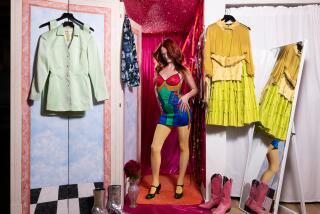Flora Gill Jacobs, 87; Former Reporter Turned Dollhouse Collection Into a Noted Museum
- Share via
Flora Gill Jacobs, whose collection of antique miniatures became the Washington Dolls’ House and Toy Museum and attracted visitors from around the world for nearly 30 years, died May 31 of congestive heat failure at Sibley Memorial Hospital in Washington, D.C. She was 87.
Jacobs was considered the country’s foremost authority on antique dollhouses and their furniture.
The author of five histories and four children’s books, she wrote the first history of dollhouses. Her latest work, written in 2005, is the comprehensive “The Small World of Antique Dolls’ Houses.” Collectors called her museum, the first of its kind in this country, one of the finest in the world.
The Washington museum, of which Jacobs was founder, director and curator, was known for its miniature 19th and early 20th century architecture and decorative arts. Jacobs often noted that much social history could be found within the miniatures.
Jacobs’ contribution to the hobby cannot be underestimated, said Noel Barrett, toy dealer and regular on PBS’ “Antiques Roadshow.” Barrett auctioned off a portion of the museum’s contents when it closed in 2004.
“Flora is one of the most famous names in dollhouse collecting of the postwar period,” Barrett once told the Washington Post. “There are other people, but she single-handedly put it on the map in America.”
A Washington native, Jacobs attended George Washington University, where she wrote movie and theater reviews for the Washington Times-Herald.
At 23, she was promoted to women’s page and fashion editor at the paper. Later, she became one of three general assignment reporters for the women’s pages at the Washington Post.
By 1945, however, her interests in writing had turned to books and the topic of dollhouses. “I’m a writer who became engulfed by a collection,” Jacobs once said.
Her first book was published in 1953, “A History of Dolls’ Houses,” depicting the most famous European and American dollhouses from 1558 to the 1950s with more than 150 photographs.
She found her first dollhouse in an old barn in New Jersey in 1945 and paid $35 for the post-Civil War mansion. It was such a “wreck” that it seemed haunted, she said. Jacobs restored it and filled it with early to late Victorian furniture, chandeliers and marble tabletops. The house became the inspiration for her first children’s book, “The Doll House Mystery,” published in 1958.
Her next book, “The Toy Shop Mystery,” published in 1960, was based on another addition to her collection, a rare toy shop, from about 1800.
The more she collected and wrote, the more interest mounted in the Lilliputian houses, shops, dolls and toys she kept in her Maryland home. “Friends, Brownie troops, people who had heard about it, all wanted to come see my personal collection,” she told the Post in 2000. “I thought I had to find a way to share it with them.”
In 1975, she opened her museum and people came from all over.
Sometimes as many as 20,000 visitors a year bought the modestly priced tickets -- $3 for adults and $1 for children -- at the antique post office window.
Jacobs fussed over her “serious collection,” as she often reminded those expecting a doll museum.
Her museum included several houses adorned with late-Victorian gingerbread, a six-story Victorian hotel with furnished guest rooms, a German rendition of George Washington’s farm and an elaborate three-story Mexican mansion with a roof garden, aviary and elevator.
Upstairs at the museum was the Edwardian Tea Room, where generations of children enjoyed birthday parties amid early 20th century decor and service from a waitress in a starched apron and cap.
She was known for authoritative writing and lectures. Her other books include “A World of Dolls’ Houses” (1965), a history for children; “A Book of Dolls and Doll Houses” (1967); “Dolls’ Houses in America” (1974); “Victorian Dolls’ Houses and Their Furnishings” (1978); and the children’s’ book “The Haunted Birdhouse” (1970).
Survivors include her husband of 65 years, Ephraim Jacobs, of Chevy Chase, Md.; and a daughter, Amanda Jacobs of Centreville, Md.
More to Read
The biggest entertainment stories
Get our big stories about Hollywood, film, television, music, arts, culture and more right in your inbox as soon as they publish.
You may occasionally receive promotional content from the Los Angeles Times.










